Panasonic TX-P55VT50 Review
Panasonic TX-P55VT50
Exclusive: It's big, beautiful and brilliant. Say hello to Panasonic's new flagship 55in TV.
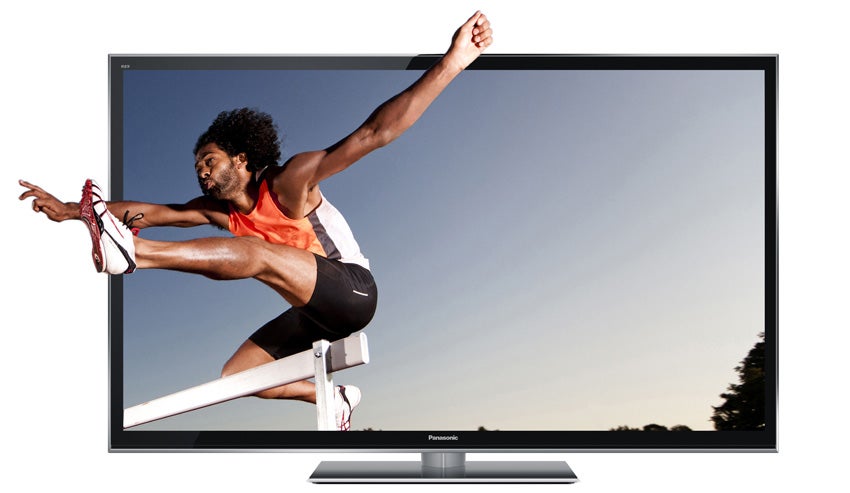
Verdict
Pros
- Sensational 2D and 3D pictures
- Gorgeous design
- Mostly good online system
Cons
- Pictures not especially bright, especially with 3D
- Panasonic's own ST50 series offers stiff competition
- Touchpad remote is flawed
Key Specifications
- Review Price: £2399.00
- 55in plasma TV
- Active 3D playback
- Two 3D glasses included
- Dual core processing
- Smart TV online and multimedia features
The arrival of any new flagship plasma TV from Panasonic is usually a reason to rejoice. But this year we’re feeling even more enthused than usual at the sight on our test benches of the brand’s new 55in flagship, the P55VT50.
For starters, it looks gorgeous. Over recent years Panasonic has veered between conservative and downright dull with its TV designs, yet its P55VT50 picks up beautifully from where its recently reviewed P50ST50 left off. Its bezel is remarkably slender – trimmer, indeed, than that of the Samsung PS51ES8000. Also, the black frame is offset delightfully by a glinting metallic trim around its extremities.
The Panasonic P55VT50 is rather less trim on its rear than many LCD TVs, but as we’ve said many times before, you look at a TV’s front, not its back. So a few cm of extra rear needn’t matter in the slightest if the picture quality coming out of the TV’s front justifies it.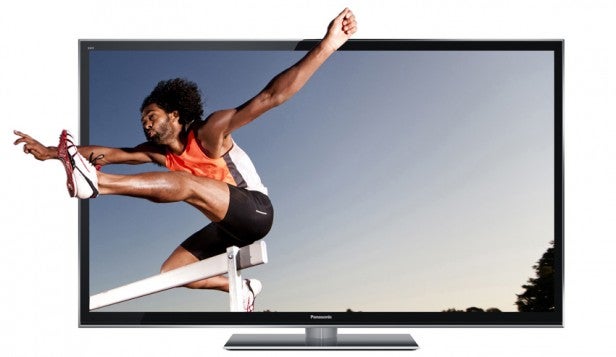
The P55VT50’s connections are as comprehensive as you would expect of a modern flagship TV, including four v1.4 HDMIs, a D-Sub PC port, built-in Wi-Fi for online and DLNA streaming, plus three USBs for playing back multimedia files and recording from the built-in tuners.
Freeview and Freesat are go
These tuners unusually embrace both Freeview HD and Freesat HD, meaning you should be able to get HD broadcasts no matter where you live.
Having already reviewed the cheaper P50ST50, a good way to start looking into the Panasonic P55VT50’s specifications is by tracking down how it improves on the already strong spec of its cheaper sibling.
First up is the aforementioned design, which is even nicer than that of the also-glam P50ST50. Next, the P55VT50 employs dual-core processors while the P50ST50 did not. This creates a number of knock-on differences. For instance, it lets you multitask – as in, have open simultaneously multiple applications, with simple switching between each app.
It also boosts the power and speed of the TV’s video processing – resulting, most notably, in a world-first ‘2500Hz’ Focussed Field Drive claim. The P50ST50, by comparison, ‘only’ had 2000Hz, while LG and Samsung’s 2012 plasma screens top out at 600Hz.
The Panasonic P55VT50’s stronger processing engine allows it to produce a remarkable 24,576 steps of gradation too.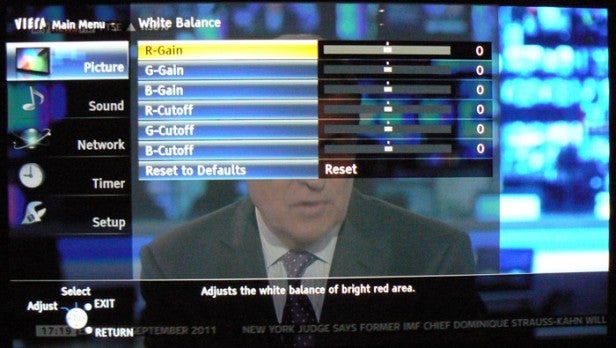
It also adds Panasonic’s highest-quality screen filter beyond the ST50’s spec, to deliver an apparently even richer black level performance. Next, the Panasonic P55VT50 boasts the endorsement of the THX quality assurance group – for both 2D and 3D – while the P50ST50 does not. And the P55VT50 delivers four HDMIs and three USBs rather than the three and two respectively carried by the ST50s.
Free 3D glasses
Finally, unlike the P50ST50, this TV ships with two pairs of 3D glasses and a second ‘touchpad’ remote control included for free.
It’s a relief to find the 3D glasses, though our enthusiasm for the touchpad remote is tempered by the distinctly hit and miss experience we had with the same device when reviewing the Panasonic L42WT50.
Indeed, it only took a few minutes of experimentation with this remote to convince us that we still don’t like it much. The circular shape and small size of the touchpad just don’t fit comfortably with the screens you’re using it to navigate, and tapping the pad to select an option feels unnatural and unresponsive.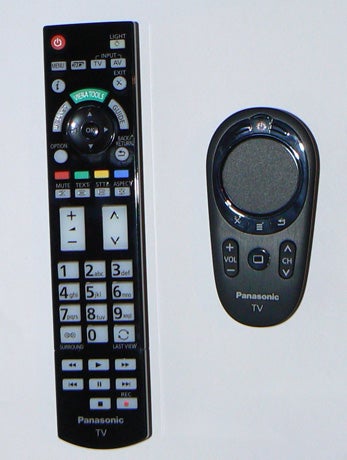
As a result, if you have an Android or Apple portable device, we strongly recommend that you download the free Viera Control App for that not only provides a much more satisfying touch-screen control experience but also allows screen sharing with what the TV is showing.
As you would expect of a TV with THX – and ISF – endorsement, it’s well equipped with picture adjustments. Colour/white balance and gamma management lead the way, while elsewhere are multiple ‘power’ settings for Panasonic’s Intelligent Frame Creation motion judder-reduction system, an optional Clear Cinema system for improving the vertical resolution for movie images, and pixel orbiter/screen wipe tools for combating plasma’s (now pretty limited) potential for image retention.
Other Panasonic TX-P55VT50 features of note inside the dull but straightforward onscreen menus include a picture in picture system, a slightly underwhelming suite of picture presets, and a simple noise reduction system.
Exploring Panasonic’s Viera Connect online platform reveals the familiar mix of pros and cons. On the upside the system seems very stable and goes about its business quickly, and there’s a decent amount of video streaming services.
Happy shoppers
The Marketplace area for buying/downloading extra apps and even hardware accessories (like keyboards and joysticks) is well presented too, with good search tools and sensibly sized icons that allow plenty of content onscreen at once.
The main menu system for accessing apps, though, while attractive, proves very cumbersome when it comes to tracking down some of your apps. Also, in an ideal world there would be more content available. Panasonic isn’t in the same ballpark as its Korean rivals in this respect. But then this does mean that Viera Connect doesn’t struggle under the weight of mountains of trivial apps. 
Rather surprisingly, we’re going to open our assessment of the Panasonic P55VT50’s performance with a slight negative.
We weren’t blown away by any of the provided picture presets – even the THX one. The Dynamic mode makes colours look overblown and exaggerates source noise and plasma’s potential issues with dotting noise over moving skin tones.
Preset issues
The Normal setting the set defaults to, meanwhile, feels too dull for our liking, even when testing the screen in a pretty dark room.
As for the THX efforts, while they might be ‘accurate’, we’re also pretty convinced they’ll look too muted and soft for most people.
Fortunately, our disappointment with the Normal preset in particular was quickly resolved simply by turning off the ‘CATS’ system that measures ambient light levels and adjusts pictures accordingly. Deactivating this made the picture much more satisfying in brightness terms, as well as more stable.
In fact, now you’re fully able to start appreciating just the sort of picture glories from the Panasonic P55VT50 that we’d been hoping for – in both 2D and 3D mode.
Starting with 2D, the star of the show is the screen’s exceptional black level response. In fact, ‘exceptional’ doesn’t really go far enough in describing a black level that genuinely gets even deeper than that of Pioneer’s final generation of KURO panels. Plus, since this is plasma technology, even the darkest of scenes appears without a trace of the backlight inconsistency so common with LCD screens.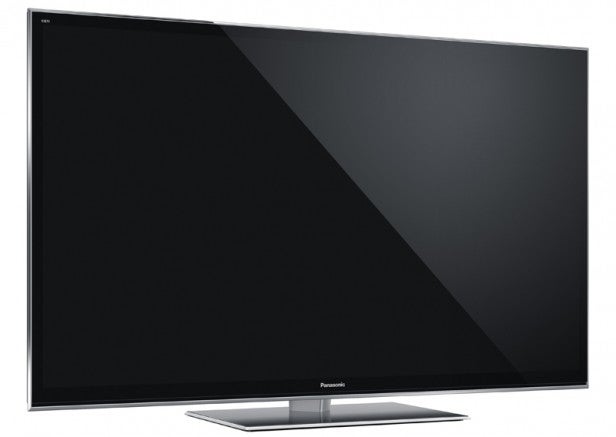
Black levels look even better on the P55VT50 than on the P50ST50, mostly because, we suspect, the more expensive screen’s enhanced filter does a better job of stopping ambient light entering the screen’s plasma cells. However, we wouldn’t necessarily say this marginally better black level response results in a more dynamic contrast range, for reasons we’ll get into later.
True colours
It usually follows that good black levels help a screen produce rich, natural colours. And this is certainly the case with the Panasonic P55VT50, as it produces a startlingly wide gamut delivered with almost infinite blend subtlety and a pretty much immaculate balance. In other words, the screen can produce reds and greens – the trickiest colours for plasma to render – exceptionally well, without them looking over-dominant or out of kilter with other tones.
People used to the glaring bright whites common with LCD TVs may feel that the Panasonic P55VT50’s more subdued reproduction of whites is a little off. But actually, aside from an occasional over-yellow tinge, the P55VT50’s warm approach to white is mostly very natural, and makes sure whites fit comfortably within the image rather than looking like white ‘holes’ ripped out of it.
The precision with which the Panasonic P55VT50 renders HD is a joy to behold too. There’s practically no noise at all so long as you avoid the Dynamic preset, and the sharpness and detail on show is mesmerising. All the more so, of course, because it’s writ large across a huge 55in screen.
There’s another key reason why HD pictures look so phenomenally detailed on the P55VT50 too: namely that plasma’s self-emissive pixel nature means there’s way more visible shadow detail in dark scenes than you get with pretty much any LCD technology.
While a screen like the Panasonic P55VT50 is obviously made to be used with as much HD as possible, it’s also surprisingly good with standard definition. It adds detail and sharpness as it remaps standard def to the screen’s full HD resolution, yet it also manages to suppress noise rather well – so long as you don’t push the screen’s brightness or contrast settings too high. Another reason to avoid the Dynamic preset, then…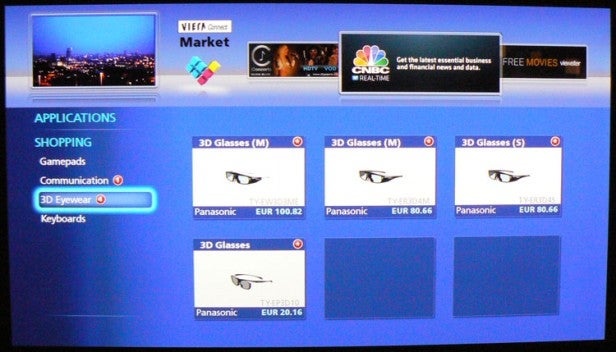
Other excellent 2D news finds the P55VT50 retaining its picture quality from almost any viewing angle, and also producing some outstanding motion reproduction free of juddering, blurring and artefacting. Provided, again, that you avoid the Dynamic setting.
This motion talent becomes even more pronounced when watching 3D, where any sort of judder or blurring issues can be extremely obvious and detrimental to the 3D effect. Nor do you need to be using Panasonic’s IFC system to get motion looking great (though you can experiment with the minimum IFC setting if you like without having to worry about it generating too many unwanted artefacts).
No crosstalk here
The Panasonic P55VT50’s 3D pictures also benefit from an almost complete absence of crosstalk ghosting noise, and the screen combines rich colours and deep black levels in a way many LCD TVs struggle to.
The boost to the TV’s sub-field driving system has improved Panasonic’s previous issues with colour blend ‘striping’ when watching 3D too. Plus, of course, the considerable size of its screen aids the immersiveness of the P55VT50’s 3D experience.
So long as you can watch in a dark room. For it remains the case that Panasonic’s 3D glasses take more brightness out of pictures than those of almost any other 3D TV – especially LCD ones. In fact, both 3D and 2D pictures look less bright on the P55VT50 than they did on the P50ST50.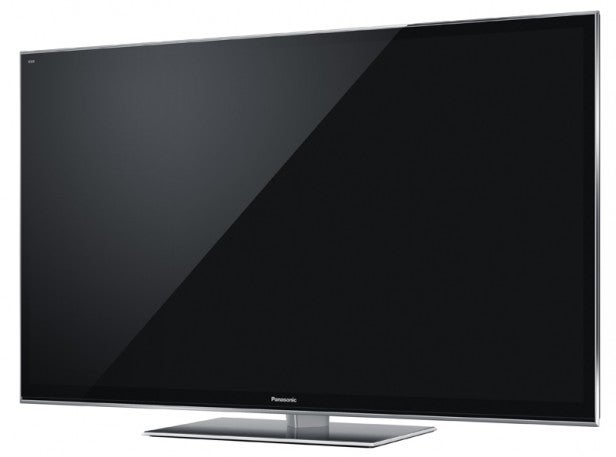
There are a couple of other issues too. First, as usual with plasma, if you sit too closely or leave the panel running too brightly, you can sometimes see gentle speckling over dark picture areas. Though this isn’t visible under sensible viewing conditions.
Gamma shifts ahoy
Much more distracting but thankfully extremely rare is the appearance of gamma shifting, where an image’s combination of bright and dark content can cause the image to ‘flicker’ as the screen struggles to settle on the right gamma level. So far as we could tell, though, as well as being rare, this phenomenon can be reduced by setting the gamma level slightly higher than you might ideally wish.
Panasonic TVs can generally be relied on to suit gamers thanks to their lowly input lag measurements. And the P55VT50 continues this trend, measuring barely 30ms using its Game picture preset.
The P55VT50’s audio seems very similar if not identical to that of the P50ST50. Which isn’t particularly great news, as it means there’s not as much bass as we’d like, and there’s a slightly ‘flat’ feeling to action scenes. But then a serious home cinema screen like the P55VT50 will likely be matched with a separate audio system.
Verdict
The Panasonic TX-P55VT50 is, predictably, a superb TV. In fact, as a 55in screen for a dedicated home cinema room it’s probably without equal.
As a main living room set, though, we can’t help but think we might prefer Panasonic’s new ST50 series. For while the ST50s lack the dual core processing and some of the black level response of their higher-specced siblings, the P50ST50’s pictures look brighter and more contrasty/punchy, making them more consistently satisfying in a typical family environment. Plus, of course, the ST50 series’ more aggressive pricing is much easier for a typical 2012 family budget to accommodate.
How we test televisions
We test every TV we review thoroughly over an extended period of time. We use industry standard tests to compare features properly. We’ll always tell you what we find. We never, ever, accept money to review a product.
Trusted Score
Score in detail
-
Features 9
-
3D Quality 9
-
Value 7
-
Design 9
-
2D Quality 9
-
Sound Quality 7
Features
| Size (Inch) | 55in |
| Display Type | Plasma |
| Max. Resolution | 1920 x 1080 |
| Full HD 1080p | Yes |
| Digital Tuner | Yes |
| Freeview HD | Yes |
| Freesat HD | Yes |
| 3D Ready | Yes |
| Contrast Ratio | 6,000,000:1 |
| Refresh Rate (Hertz) | 2500 (subfield drive)Hz |
Connectivity
| HDMI | 4 (v1.4) |
| Component | 1 |
| Composite | 1 |
| Scart | 1 (RGB) |
| Digital Audio Out | 1 (optical) |
| Headphone | 1 |
| Charging/Computer Connection | 3 |
| Ethernet | Yes |
| WiFi | Yes (built-in) |
Physical Specifications
| Height (Millimeter) | 771mm |
| Width (Millimeter) | 1286mm |
| Depth (Millimeter) | 50mm |
| Weight (Gram) | 31.5g |

